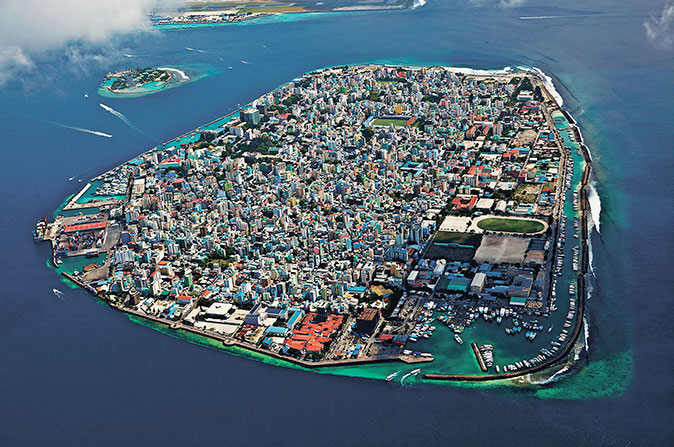Economy / Maldives
Young republic comes of age
The Maldives Celebrates 50 years of independence, and achieves remarkable economic development

Malé City, one of the smallest and most densely populated capitals in the world.
In the late 1960s, a team of UN experts published a report on the prospects for tourism in the Maldives. The conclusion was bleak: there were none. No airport. No bank. Little electricity. The obstacles were just too big.
More than 50 years later, tourism accounts for 27 percent of the Indian Ocean archipelago’s $2.3 billion gross domestic product – and that figure isn’t showing any signs of slowing. The industry’s growth rate is projected at a healthy 6.3 percent this year.
Independence from British protection in 1965 asked an urgent question of the young republic: How could this small, poor, isolated collection of islands, lacking any natural resources, save the abundant fish and ubiquitous coconut trees, become a viable state on its own?
In 2011, the Maldives answered. They graduated from being a Least Developed Country to a Developing Country. Only two other countries have ever made this leap in the United Nations Human Development Index. Accelerated economic progress in the next three years saw the island nation shoot further up the rankings. In 2014, the Maldives became an Upper Middle Island Country.
This remarkable half-century transformation is currently being consolidated and expanded with a stronger economic relationship with China. Since 2010, China has dominated its tourism market, overtaking the dominant European market. 30 percent of tourist arrivals are now Chinese.
Increased cooperation with China has given the Maldives hope that several strategic mega projects will receive financing in the near future, as their economy becomes more dynamic and open.
To incentivize the necessary foreign financing, the Maldives has passed groundbreaking reforms. Until recently insular legislation made it hard for foreigners to invest. However things have changed: there are no longer restrictions on the repatriation of profits and businesses can now be incorporated with 100 percent foreign ownership rights.
The Maldives’ decision to join China’s Maritime Silk Road will see maritime links between the two countries improve, as will the introduction of Special Economic Zones and a new Free Trade Agreement set to be signed later this year.
Despite impressive economic growth rates, there are a number of challenges facing the country: Malé, the capital city, measures just 2.2 square kilometers but accommodates more than 100,000 residents and suffers from overcrowding and high rental rates, economically active islands are poorly connected and with a majority of its population under 35, it has the highest level of youth unemployment in South Asia.
While the Maldives begins to address these socio-economic problems, its business leaders are looking outwards to build on their vibrant tourism sector. As the Indian Ocean nation confounded expectations following independence just half a century ago, it is currently looking to stimulate investment from China and consolidate its remarkable economic transformation.
